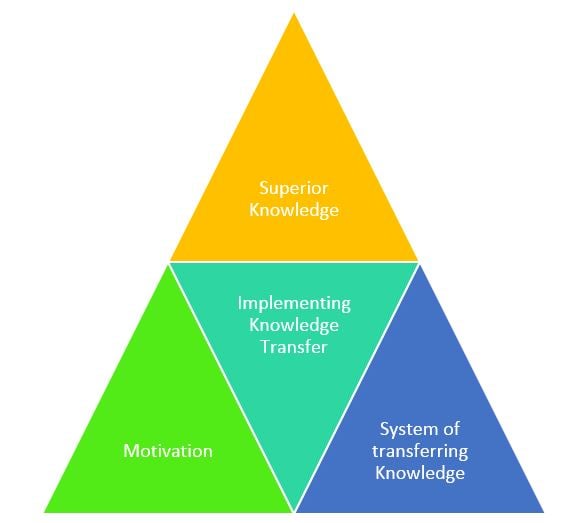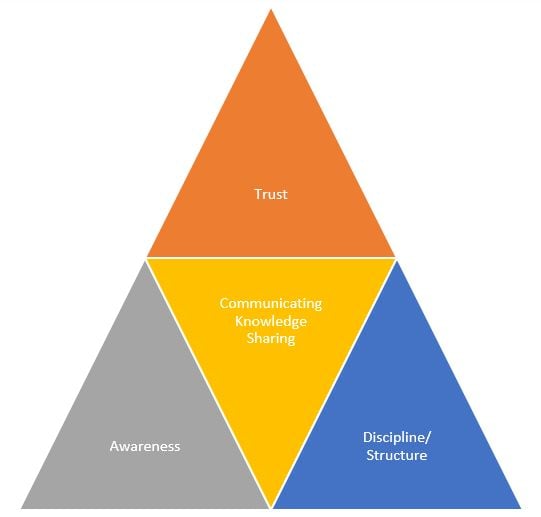
According to mitpress.mit.edu, "Knowledge management was initially defined as the process of applying a systematic approach to the capturing, structuring, managing, and disseminating knowledge throughout an organization to work faster, reuse best practices, and reduce costly rework from project to project.” Conceptualizing knowledge management at a high level is important when developing a plan to execute a company-wide knowledge management standard. Knowledge management, however, can be broken down into three segments.
Knowledge Management Segments
- Knowledge Transferring
- Knowledge Sharing
- Knowledge Barriers
These three concepts are discussed below with examples of each segment.
Knowledge Transferring
The first knowledge management segment is known as knowledge transferring. Knowledge transferring is the shifting of information/data between individuals, organizations, or externally from one source to another. On a Forbes online article it stated, “Knowing who knows what, who needs to know what, and how to transfer that knowledge is critical — especially when so much of a company’s worth consists of information.” Although most companies value knowledge transferring, achieving success with this segment is easier said than done in most cases. This is what the Forbes article discussed and I know first-hand working in an automotive manufacturing company the difficulties of knowledge transferring. It is often times frustrating because the concept seems very simple, but whenever people are involved in processes it adds an extra layer of complications.The issue within most companies is only a handful of individuals would be considered experts in a particular topic and, therefore, they end up becoming the most "expert" resource.
The core requirements for knowledge transferring are motivation, superior knowledge, and a strategic structure in place. If the source of knowledge does not possess these traits/elements then it makes the chance of success very limited. The following conditions must exist.
- There must be knowledge available and ready to be transferred that is adequately better than the receivers existing knowledge.
- There has to be a system or strategy in place to transmit and it has to meaningful to more than just one person but too many recipients.
- The knowledge being transferred has to be willingly transferred and better knowledge than the recipient’s knowledge.
Implementing knowledge transferring requires a large amount of effort from everyone within an organization and takes a lot time/patience. It will require having a good system in place with discipline from those involved and those who could be potentially be involved. Companies that are successfully achieving knowledge transfer will benefit retaining employees, develop easier training tactics, and reduce risk.

Knowledge Sharing
Knowledge sharing is defined as the exchange of knowledge amongst individuals, organizations, or industries. One point I would like to make is that although knowledge transferring and knowledge sharing seem similar these concepts have a few differences. One of the differences in knowledge sharing is it cares primarily about the existing knowledge that the person receiving the information might have. In knowledge sharing, it is more of a collaborative effort between the giver of information and the receiver of that information whereas for knowledge transferring the prior knowledge of the receiver is irrelevant and insignificant. The major factors to consider in knowledge sharing are the following trust, awareness, and discipline/structure. The following conditions must exist.
- The individual with more experience must trust or have feel some sort of connection with the individual receiving the knowledge in order to extract the most optimal information. If this is achieved sharing knowledge becomes a lot easier on both parties if they feel comfortable with one another.
- Both parties have to have a sort of awareness on what each party already knows. In order to share information it has to be something new or something that one party does not know. One useful element of knowledge sharing is ensuring both parties teach the other party knowledge that the one party is not aware of. Both parties must benefit in order for knowledge sharing to be beneficial.
- The last element is perhaps one of the most important points. A structure of distributing the information has to be prepared before the knowledge can be shared. Elements like how to communicate, how to optimize communication, who will be sharing what content, and so much more must be discussed. A prior plan containing different questions and sources to make the information accessible to multiple different groups or individuals relatively easy.

Knowledge Barriers
The last segmented in knowledge management is knowledge barriers. Knowledge barriers are defined as a delay or deterrent in the process of knowledge management that can occur through many different ways such as technology, content, people, organization, expansion, and more. The top three barriers I would suggest are communication, people, and expansion.
- Communication barriers could be within the material that is being conversed. Also maintaining and expanding knowledge management takes a lot of communication between the various parties involved but it also requires a particular form of communication. Usually face-to-face interaction is the most effective way of expressing knowledge, but it can used in other forms of communication.
- When I refer to people as being a barrier, it is used for a lot of different aspects that individuals can play a factor in. Culture plays a factor in the way individuals try to proceed with knowledge management along with experiences. It changes the way individuals view topics and so much more. This can be a positive if looked at creatively but negative if the knowledge does not come across easily by others.
- When expansion occurs often times companies must be careful not lose the system they have in place, if they do or lose sight of the standard that already exists. Keep a clear vision in sight because once a company is immersed in a new setting, it is easy to lose focus and deviate from the original plan.
In conclusion, I hope this blog has given more insight on the types of knowledge management, which are knowledge transferring, knowledge sharing, and knowledge barriers. This blog is not meant to be a solution to knowledge management but more of an informative blog to express the topic at hand. Most companies in various industries will struggle to achieve an effective and efficient method of knowledge management because different factors contribute to the overall success of this concept. The key to have a good knowledge management system and to keep a consistent standard across the board while also being able to communicate the knowledge with the right resources and right way. This topic is very broad and it is one of the most important topics that companies are investing significant resources into because of the cost saving opportunity and growth of the company.
Different forms of Knowledge Management

References:
- mitpress.mit.edu - https://mitpress.mit.edu/sites/default/files/titles/content/9780262015080_sch_0001.pdf
- Forbes - http://www.forbes.com/sites/chriscancialosi/2014/12/08/6-key-steps-to-influencing-effective-knowledge-transfer-in-your-business/



